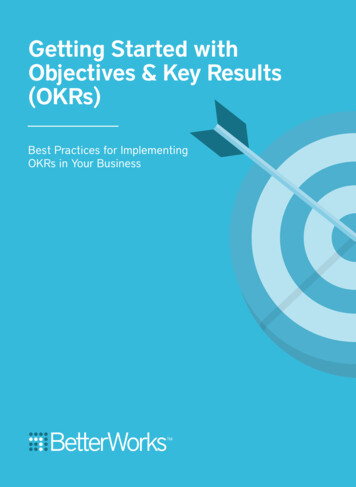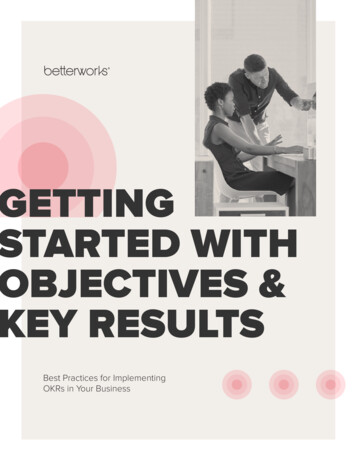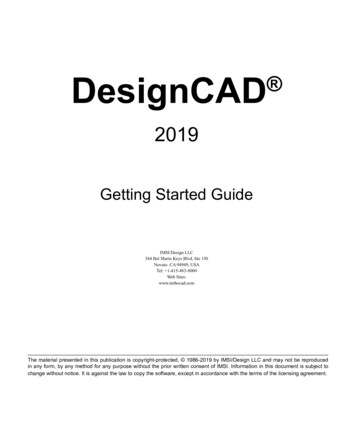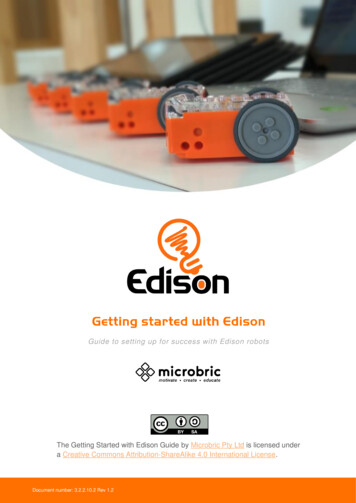
Transcription
Getting Started withObjectives & Key Results(OKRs)Best Practices for ImplementingOKRs in Your Business
Share this ebook:www.betterworks.com
Table of ContentsThe Basics. What are OKRs?6The Right Fit. Are OKRs Only Useful for Certain Organizations?9Setting OKRs. Where to Start?10A Closer Look. How Did John Doerr Explain OKRs?12More OKR Examples14Cadence. How Often Should OKRs Be Set?16Teams. How Do OKRs Engage a Multigenerational Workforce?18Measurement. How Should OKRs Be Scored (or Should They)?20Human Resources. How Do OKRs Work with Performance Management21Potential Issues. How Can Enterprises Address Them?23Input and Tracking24Next Steps. How Do Organizations Extend OKRs26About BetterWorks27
“Ideas are precious, but they’re relativelyeasy. It’s execution that’s everything.”– John Doerr, partner at Kleiner Perkins Caufield & Byers
IntroductionSince the 1950s, business leaders have embraced a variety of management techniquesdesigned to improve employee performance. Peter Drucker introduced Management byObjectives (MBOs), a process during which management and employees define and agreeupon objectives and what they need to do to achieve them. In the early 1980s, S.M.A.R.T.goals and Key Performance Indicators (KPIs) became popular methods for organizationsto set objectives. Then in 1999, John Doerr introduced Objectives – Key Results (OKRs) toGoogle, a model he first learned about at Intel, and revolutionized goal setting. Today, OKRsare a de facto standard for aligning company and individual goals.A management methodology that helps businesses focus effort on the same importantissues throughout their organization, OKRs have been cornerstones to improvingoperational excellence at industry leaders such as Intel, Oracle, Google and others. Yet asemployees leave these companies for start-ups and other ventures of their own, fromTwitter and Zynga to LinkedIn, they are bringing the OKRs model with them as a way todrive organizational alignment.This eBook is designed to help your organizationUnderstand the value of OKRsBegin to effectively set OKRsChoose the right OKR softwareOKRsMBOsThe Effective Executiveby Peter Drucker19671973S.M.A.R.TGeorge Doran’s“S.M.A.R.T. Way”1981John Doerr introducesOKRs to GoogleKPIs19841990199920125
The Basics. What are OKRs?OKRs are a framework for employers and employees to discuss how the work of anindividual employee is connected to the overall business strategy. When championed bymanagement and implemented throughout a business, OKRs help organizations toImpose disciplined thinking so major goals surfaceInform everyone about what’s importantEnable more accurate communicationEstablish indicators for measuring progressFocus effort and ensure ne—top-down,cross-functionally—OKRsJohn Doerr, the father ofOKRs, talks about goals for theenterprise.ensureeveryone is working toward the same result.Watch the videoRead the Q&AWhat is an objective? - What I want to accomplishObjectives should be significant to the company and personally meaningful, as well asaspirational. They should also be aligned and supported by the entire organization.Example: Put a man on the moon by the end of the decadeWhat are key results? - How I will accomplish the objectiveKey results should clearly make the objective possible, be measurable, limited in number,and time-bound.Example: Build a lunar module weighing under 40,000 pounds by December 19656
“Once-a-year or every six-month feedback is notfrequent enough to meet the ever-changingpace of business.”1— Paul D. Hamerman and Claire Schooley, Forrester ResearchHow many OKRs are ideal?Best practices encourage setting four to six objectives and five or fewer keyresults for each objective.How should they communicated?Organizations foster clarity and transparency by hosting Q1, Q2, Q3 and Q4 atshowindividual,teamandcorporate-level goals with associated performance metrics.Q31Forrester Research. “Disrupt the Employee Performance Process to Align with Business and Customer Outcomes,”Paul D. Hamerman and Claire Schooley, July 2, 2014.7
How do OKRs fit with S.M.A.R.T.?S.M.A.R.T is a basic goal-setting tenant because it helps remind employees that every goalthey set should be:S — ��TemporalBut goal setting has evolved since the introduction of S.M.A.R.T more than 30 years ago.Best practices are to create specific, measurable, relevant and time-related OKRs, butrather than always be attainable, OKRs should be aspirational.Companies that are recasting the “A” from attainable to aspirational may not always achievetheir goals, but they foster greater innovation by encouraging workers to push their limits.OKRs are more akin to stretch goals – a little uncomfortable and slightly out of reach.Beyond S.M.A.R.T., OKRs also help organizations better answer other meaningful questionslike, who is involved with a goal? How does the person setting goals get feedback and trackprogress? Why is a goal important to the individual and the company? 32,0008
The Right Fit. Are OKRs Only Useful forCertain Organizations?OKRs are a good fit for all types and sizes of organizations because they lead to theorganizational alignment that drives operational excellence.Large enterprises – In organizations with many departments, it’s critical for all members ofthe team—across teams, top to bottom, and across functions—to be able to providefeedback and input into the goal-setting process. By making everyone’s goals transparentand visible, organizations can attain and maintain alignment. The process of recordingoperational goals (e.g., grow revenue, hire employees, etc.) and aspirational goals (e.g., howan individual will help the company move into a completely different space, revolutionize amarket, etc.) drives operational excellence. Google successfully used OKRs to grow from 40 to40,000 employees. OKRs can also be effective tools for retaining top talent.Small and medium-sized (SMB) organizations – As organizations try to determine marketfit or maintain competitive advantage, OKRs keep employees driving toward the samegoals. SMBs may set and evaluate goals more often than enterprises.Service firms – In more fluid reporting structures, such as highly projectized consultingorganizations where individuals move between projects, it’s important to provide a way foremployees to see and support the work being done by other team members—onsite and offsite.“Activity does not always equal progress. Vision withoutoperational excellence just becomes a dream. Greatenterprises marry a huge sense of purpose withamazing operational excellence.”— Deep Nishar, former senior vice president of products and userexperience at LinkedInWatch the video9
Setting OKRs. Where to Start?“Innovation withoutexecution is hallucination”- Albert EinsteinThe most difficult step for many organizations is committing to the OKRs process.Businesses should identify an OKRs “champion” who fully understands the benefits of theapproach and can help teams that may be having difficulty getting started or staying ontrack. This person is often a chief executive, line-of-business leader, operating officer orhuman resources professional.OKRs are a multi-step process. Businesses may choose to roll out the entire OKRs processat once or simply one step at a time:Ask employees to individually set OKRs.Establish a time frame after goals are set (one day, one week, etc.) during whichmanagers meet 1:1 with employees to review OKRs.Establish a time frame after goals are negotiated for a larger group (e.g., all employeesin a group) to review and collectively negotiate departmental OKRs.Establish a time frame after goals are negotiated by the group to present OKRsto everyone in the company during an all-hands meeting.It is important to start with and keep teams centered on four-to-six objectives at a timewith five or fewer key results for each objective. Focus will yield the best results for employees at every level.10
From a practical standpoint, OKRs typically fall into twolarge buckets:OperationalThese are the goals having to do with a company’s metrics,for example, project plans related to product releases,hiring, market share, etc. They are the organization’soperating drumbeat. Management will typically set theseat the company level while employees set operational goalsat departmental levels.AspirationalIn contrast to operational goals, aspirational goals arebigger picture ideas about how a company is going to goabout changing the world. These goals set the scene andare designed to help all employees figure out how they cancontribute to the aspirational ideas. Aspirational goals cancome from any level in the organization.Both sets of represented goals must be as measurable aspossible and measurement should be linked, for example, “Iwill accomplish this goal by doing x, y and z.” When bothoperational and aspirational goals are visible, all employeesknow how a company is oriented and also understand thatthinking big is required. Additionally, some operationalgoals may be aspirational because one size does not fit all.Forrester Research. “Disrupt the Employee Performance Process to Align withBusiness and Customer Outcomes,” Paul D. Hamerman and Claire Schooley, July 2,2014.1211
A Closer Look. How Did John Doerr Explain OKRs?football analogy:John DoerrSand Hill Unicorns General ManagerObjective:Make for OwnersKey Results:1. Win Super Bowl2. Fill stands to 88%Larry Page - Head CoachWin SuperBowl1. 200 yrd/game passing attack2. 3rd ranked defense in NFL3. 25 yds. punt return average@Jack - Head of PRFill Stands to 88%1. Hire 3 colorful players2. Get 2 Monday Night games3. Highlight key players12
Doerr's ExampleJohn DoerrSand Hill Unicorns General ManagerObjective:Make for OwnersKey Results:1. Win Super Bowl2. Fill stands to 88%Larry Page - Head CoachWin SuperBowl1. 200 yrd/game passing attack2. 3rd ranked defense in NFL3. 25 yds. punt return averageDefense#3 DefenseLess than 100yrdpassing a gameOffense200 yrd passingattack75% completionSpecial Teams25 yrd punt returnaverage3 blocked punts@Jack - Head of PRFill Stands to 88%1. Hire 3 colorful players2. Get 2 Monday Night games3. Highlight key playersNews StaffGet 2 MondayNight games5 ESPN specialfeaturesScoutsHire 3 colorfulplayersVisit top 25collegesPublicity AgentGet mediacoverageHire 10 newcheerleaders13
More OKR ExamplesTable 1 is an example of OKRs that a senior executive might set. Because employee goalstypically cascade from management goals, Table 2 provides examples of line-of-businessmanager OKRs from various departments across the business.Senior Executive OKRsType: OperationalObjectivesImprove FinancialIncrease CustomerMeasure EmployeePerformanceSatisfactionEngagement- Close three deals- Increase upgrade- Institute bi-annual,over 10Mconversions to 10%- Engage customersthrough featuresKey Resultsvoting (seecompany-wide NPSsurvey- Deliver resultswithin 60 days“Innovation” objective)Type: AspirationalObjectivesIncrease MarketInnovationGrowthLeadershipKey ResultsAccelerate Strategic- Sign partner- Move into the- Institute “suggest“Challengers”your own feature”agreement tocategory of thewithin product by 2/15expand into LatinGartner MagicAmerica by Q2Quadrants (MQs)14
Manager OKRs (Various Departments)Type: OperationalObjectivesKey ResultsImprove FinancialIncrease CustomerMeasure EmployeePerformanceSatisfactionEngagement- Enable digital- Grow per day- Develop NPSsignatures forviews to 10,000 bypurchase orderspersonalizing- Add a systemsengineer to eachproof of conceptcontent- Run quarterlyphone blitzsurvey by 1/20- Automate surveydistribution andresults collectionby 2/15campaign targeting- Read out resultstop 100 customerswithin 30 daysType: AspirationalObjectivesIncrease MarketDrive InnovationLeadershipGrowth- Trial three new- Engage with fiveanalysts publishingsimilar productpossible partnersrelevant MQsfeatures per- Meet with GartnerKey ResultsAccelerate Strategic- Get three referencecustomers to speakwith Gartner analystquarter, enableusers to vote- Collect results andsolicit other ideas- Conduct duediligence by Q1- Work closely withlegal to developcontract terms by Q2- Build most popularfeatures into Q2product releaseWell-developed OKRs are very powerful tools. Employees across the company (andaround world) can link their goals to the corporate goals, knowing that their work ishaving a direct impact on the success of the business. Moreover, corporate goals shouldbe inclusive of ideas that are created at the individual contributor level, which keepssenior leadership in tune with the organization. For example, at least 60% of objectives atmany companies come from bottom-up because too much top-down dictation killsmotivation and aspiration.15
Cadence. How Often Should OKRs Be Set?Q1Q3Q2Q4Q4Most organizations work through OKRs quarterly. However, some companies have beenknown to set OKRs in monthly or six-week intervals. It is important to be sure the cadencematches the stage and culture of the business.For example, setting OKRs quarterly may be too long for a very early stage company tryingto determine its market fit. It may also be too long for a unit within a larger company thatis working to substantially change its delivery processes. The reason the interval isimportant is because over time, the relevance of goals diminishes in fast-paced environments.Whether the cadence is six weeks, one month or quarterly, businesses will typically seehuge operational wins when they move from annual assessments to more frequent goalsetting. Moreover, because agility is a key indicator of business success, companies shouldconsider providing a way for employees to set, show progress, and get feedback on goals daily.16
In “Start-Up Speed,” Kristen Gil, VP of Business Operationsat Google, explains some of the changes Google institutedto help it operate at small business speed, even as it grew.Use OKRs To UnifyCreating quarterly OKRs has been part of Google’s culturesince board member John Doerr introduced the concept portance and are using the quarterly OKR all-handsmeeting (which is led by Larry Page and other companyleaders) as a rallying point for all employees. Team by team,the leaders lay out their objectives and how they’ll measuresuccess. Afterwards, they’re posted for anyone within thecompany to see.To make sure our products work seamlessly together —always as companies grow big company goals thatcan only be achieved if everyone works together. Forexample, a recent OKR objective for our search team was toimprove the world’s information and make it universallyaccessible and useful, which restates and reiterates thecompany’s mission statement. The key results underneaththat objective included metrics and projects for the quarter,many of which span a number of teams, ensuring awell-coordinated push toward a shared goal. Having theseshared goals also has the benefit of helping prevent theformation of silos — always a concern as companies grow.22Think with Google. “Start-Up Speed,” January 2012.17
Teams. How Do OKRs Engage a Multigenerational Workforce?Although the Baby Boomer generation dominates the workforce today, many olderemployees will retire in the next 10-15 years. The challenge for businesses is to replace thisgroup that currently holds leadership positions with new talent that keeps innovating. CEBrecently completed a Talent Report, based on millions of assessments of employeesworldwide. The results (shown in Table 1) identified six motivational factors that any3manager must be aware of to engage and retain a multigenerationalworkforce.In the PWC “Millennials at Work” report, authors offered six suggestions to businesses tohelp ensure they understand the millennial generation and are acting to attract and inspirethe best of them:Understand this generation - Use metrics to segment the workforce to better understandand address generational differences and tensionsGet the ‘deal’ right - Ensure everyone knows what is expectedHelp millennials grow - Understand personal and professional goalsFeedback, feedback, and more feedback - Give real-time, honest feedbackSet them free - Provide flexibility yet clear instruction and concrete targetsEncourage learning - Deliver continuous training and developmentAllow faster advancement - Value results, not just seniorityExpect millennials to go - Build churn into business plans4OKRs are an ideal way to help organizations manage and keep generational groups workingtoward common objectives. By establishing clear goals and making them visible companywide, everyone on the team gains a better understanding of what tasks are important towhom, how individuals prioritize them, what motivates employees across generations, andhow the workforce can team to achieve success.18
BoomersGen X’ersMillennialsWhat gets me out of bed in the tile3050545970What brings me back the next day?AutonomyPercentile41 423057Progression70Percentile3040535970What will make me stick around?Personal Principles30 32Percentile427050Personal Growth3032Percentile485470Table 1: Motivation by Generation Numbers represent percentile ranking3 CEB.“The CEB Talent Report: Big Data Insight and Analysis of the Global Workforce.” SHL Talent Measurement, June 2014.4 PWC.“Millennials at Work. Reshaping the Workplace,” 2011.19
Measurement. How Should OKRs Be Scored(or Should They)?Historically, Google has emphasized the importance of defining scoring criteria for each keyresult—and Google takes an ambitious approach to measuring OKRs. Executivesrecommend that employees consistently achieve scores of 60-70%. Individual scores foremployee goals are automatically calculated by a proprietary application.The OKRs model is most effective for businesses tion process. Keeping the two distinct encouragesemployees to set aspirational OKRs and work toward them.Tying the two together stunts innovative thinking and ad about Google’s scoringpractices, and how OKRshelped Google grow from 40to 40,000 employees.behavior.“A retrospective look at how employee skills align withjob requirements may be useful, but it doesn’t drive theresults that the business cares about.”5— Paul D. Hamerman and Claire Schooley, Forrester ResearchIs it critical to assign scores if it’s a subjective process and one that could be prone to gameplaying? Because the achievement of individual OKRs should not be (and typically isn’t)directly related to a performance review or compensation, scoring OKRs may becomeunnecessary. Depending on your company culture, self-assessment and peer-assessmentmodels may be as effective in goal measurement strategies. In cases where companies havechosen not to score goals, employees take time for self-reflection. They think deeply aboutwhat they achieved and did not achieve before setting a next set of goals.5Forrester Research. “Disrupt the Employee Performance Process to Align with Business and Customer Outcomes,” Paul D.Hamerman and Claire Schooley, July 2, 2014.20
Human Resources.How Do OKRs Work withPerformance ManagementAlthough whether to measure OKRs or not may be a topicof debate in an organization, there should be no questionas to whether OKRs should be tied to performanceevaluations. The answer is they should not.“Refactor your performance process so that you cancontinuously measure and recognize employees forachievements and outcomes that drive business success.”— Paul D. Hamerman and Claire Schooley, Forrester ResearchAs a best practice, OKRs should be decoupled fromperformance evaluations so individuals feel free to rating the two also means employees won’t spendtime trying to game the system to reap rewards.Performance management systems and are typicallysubjective and can be extremely demotivating. In contrast,OKRs are designed to bring alignment, focus, bettercoordination, and sometimes even fun, to companies.66Forrester Research. “Disrupt the Employee Performance Process to Align with Businessand Customer Outcomes,” Paul D. Hamerman and Claire Schooley, July 2, 2014.21
The question may also arise as to whether human resources (HR) should be responsible forthe OKRs process in the organization. According to Josh Bersin, Principal and Founder ofBersin by Deloitte, “The HR role is a difficult one today because leaders are being asked tocontinue to do their job of making sure the business and employee interactions are fair, incompliance, and don’t create risk for the business. HR professionals are also now beingasked to be innovators. I think HR teams can be great facilitators to their businesses withouthaving to ‘own’ every domain.”Although HR may not be the champion for the business, HR staff can actively help to makethe transition to the OKRs process and the on-going adoption of OKRs a smooth process.“What you’re going to find in the really high-performingcompanies is that HR is really a people-optimizationfunction. They are looking at the way people work. Theway they set goals. The way work gets done.”— Josh Bersin, Principal and Founder of Bersin by DeloitteWatch the videoRead the Q&A22
Potential Issues. How Can Enterprises Address Them?Inevitably, there will be some trial and error as executives, managers and employees adoptthe OKRs process. Because one size does not fit all, the OKRs champion should be awareof individuals and teams finding the most success and those having the least success withOKRs, and work to understand why. Critical assessment, especially in the first few quartersof a roll out, and modifications to the process will be keys to on-going success.As adoption grows, OKRs champion John Doerr and others recommend addressingpotential issues such as the following early:Lack of support across the entire organization - For OKRs to be effective, goals mustbe supported by the entire organization. Every team and working group should agreeon goals and priorities.Lack of accountability - Just setting goals isn’t enough. Goals must be measurable orhave quantifiable targets. From shipping a certain number of products to hitting arelease schedule, teams have to be able to track and measure the goals they set.Lack of reality, especially timing - Goals should be aggressive yet realistic.Individuals and teams should stretch, but not to the point of breaking.Lack of risk - OKRs should not be tied to bonus payments. Organizations should thinkabout using OKRs to build a bold, risk-taking culture.“Leaders must evaluate employees holistically bydiscussing with employees how they have met theirgoals, their contributions to the team, how they haveworked collaboratively to drive business value, and howthey have embraced the organizational culture.”7— Paul D. Hamerman and Claire Schooley, Forrester Research7Forrester Research. “Disrupt the Employee Performance Process to Align with Business and Customer Outcomes,”Paul D. Hamerman and Claire Schooley, July 2, 2014.23
Input and Tracking.When an organization has fewer than 10 employees, setting and sharing OKRs in a Googledoc or an Excel spreadsheet may be practical. Yet as a business grows, it requires a morerobust enterprise goal-management platform to capture, share and track progress towardkey objectives and results.Any business evaluating software to track OKRs or manage goal setting should ask lowingcriticalgoal management capabilities:1. Does the software support both bottoms-up origination of OKRs with individuals,as well as top-down, cascading processes where managers define OKRs for theirdirect reports?2. Can OKRs cross teams to enable horizontal alignment / flag dependencies ormust they be set up separately for each team as dictated by the organizational chart?3. How easy is it to access updated OKRs? Are there mobility options?4. Can anyone see a history of how OKRs change over time? Is charting available?5. How does the software encourage behaviors, such as frequent check-ins, to keep goalsand progress fresh?6. How easy is it for colleagues to support, collaborate, encourage and comment on oneanother’s goals?7. What engagement techniques exist in the software to drive adoption, usage andre-engagement? Are there notifications, social gestures and feedback loops?2418
8. What dashboard capabilities exist to serve as an early-warning system for the company?At the executive level, the manager level, and individual level, what types of notificationsare available?9. What examples of enterprise-scale deployments has the software served?10. Does the software try to combine many other features, or does it really solve the OKRsproblem deeply? And most important, will employees actually want to use rather than itbeing forced on them?25
Next Steps. How Do Organizations Extend OKRsto Further Operational Excellence?Today’s best practices for managing and tracking business objectives include modernGoal Science thinking based on five spirationalVertical/horizontalWorkingFrequent, measurableFlexibility to respondGreater achievementalignment andtransparently withfeedback andto changing goalsand encourageclaritypraise, reinforcementfrequent winsand business needsexcellenceand recognitionModern goal-setting platforms support these practices by ensuring goals are easy to set,manage, track and see throughout an organization.“OKRs are a timeless framework, but the methods forimplementing them are antiquated. They need to bemodernized.”- Kris Duggan, CEO and Co-founder of BetterWorksListen to Kris’s conversation withUpstart Business Journal26
About BetterWorksBetterWorks is an enterprise goals platform trusted by high performing companies toengage, empower and cross-functionally align their workforces. By applying Goal Sciencethinking, BetterWorks meets the needs of millennial and mobile workers with the securityand scalability that enterprises demand. Our goal is to drive companies to becomeoperationally excellent and provide powerful insights about how work gets done.Founded in 2013, the company is headquartered in Palo Alto, CA, with an office in NewYork, and is privately held and funded by venture capital firms Kleiner Perkins Caufield &Byers and Formation 8. BetterWorks has an elite team with talent from industryinnovators including Palantir, Yammer, Box, Adobe, Cisco and Salesforce.com. To learnmore about BetterWorks, visit www.betterworks.com.27
Share this book:www.betterworks.com
Objectives (MBOs), a process during which management and employees define and agree upon objectives and what they need to do to achieve them. In the early 1980s, S.M.A.R.T. goals and Key Performance Indicators (KPIs) became popular methods for organizations to set objectives. Then in 1999,










